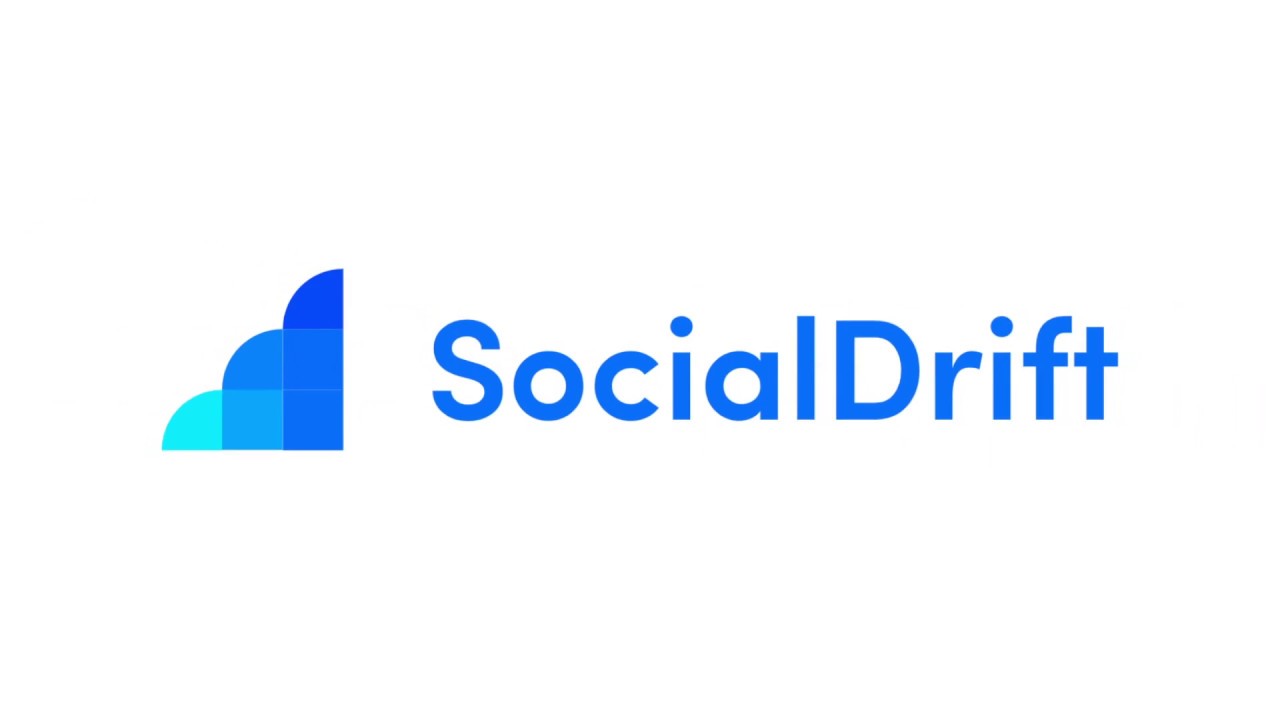3 essential strategies to increase website traffic
Looking to increase website traffic? Leverage the power of these 3 essential strategies:
- Blogging
- Social media
- Influencers
1. How to leverage the power of blogging to generate website traffic
To generate website traffic you need content and blogging is the most effective way to create content.
Is blogging easy?
No, it’s not, but companies with blogs generate on average 67% more leads per month than companies that don’t blog.
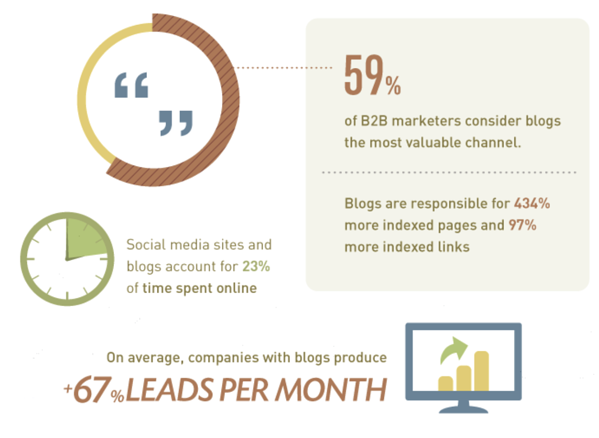
source: hubspot.com
It is a well-known fact that Google loves fresh content so companies that publish new content consistently have a lot to gain and I’m not talking about traffic alone.
Successful companies like HubSpot or Salesforce have grown into content publishing powerhouses. They put out several blog articles a day filled with valuable insights, how-to’s and other recommendations for marketers and sales professionals.
Companies like these two either have a 5-6 writer in-house team or hire freelance writers. Another solution is to welcome guest posts. No matter which option they went with, they have a well-planned editorial calendar for at least 6 months in advance.
It’s totally understandable if your company cannot publish five articles a day, not every company has the human and financial resources of Hubspot and salesforce.
You can start by publishing one article per day. You don’t have a content writer on your team yet? No problem!
Find industry experts or influencers in your niche who are looking to increase their personal brand and invite them to contribute guest blogs.
It’s a win-win situation: contributors boost their visibility and reputation, and your blog benefits from increased traffic from prospects you could turn into leads then customers.
Now that you have writers generating content, it’s time to ensure your published content shows up in Google search results and gets clicked on. In other words: it’s SEO time!
SEO recommendations to get your content to show up in Google search results and get clicked on
1.Keywords with high search volume vs keywords with low search volume
Before jumping into writing content, Nadya Khoja, Chief Growth Officer at Venngage and experienced B2B marketer recommends marketers to determine the search intent of their B2B audience.
Nadya says marketers shouldn’t choose keywords based solely on search volume. When it comes to B2B, marketers should choose keywords and terms that are first and foremost relevant to their audience even if they have a lower search volume.
“Popular searches in your industry will attract more B2C consumers, whereas focused keywords that have a higher value, but a lower search volume, usually fall in the B2B realm.”, says Nadya.
2. Put honey in your titles
The most important element of your blog article is not the contents, but the headline. If the headline is not attractive enough, no one will read the contents.
Think of the headline as honey: it’s sweet and nutritious and bears cannot resist but eat it whenever they find it.
What does a “sweet” headline look like?
A compelling headline:
- offers a solution to the reader’s problem;
- includes an engaging qualifier (i.e.: smart, amazing, easy-to-implement, top, essential, the latest etc);
- is clear on what solution does the article provide (i.e.: recommendations, insights, takeaways, tips, trends etc);
- provides a number (i.e.: 7 recommendations, 25 takeaways).
To help you get really good at writing enticing headlines, use Headline Studio, a Chrome tool that scores your headlines and teaches you how to optimize them.
3. Serve readers with a 3-course meal type of content
Health experts recommend never eat until you are full, eat until you are no longer hungry.
It’s sound advice to prevent overeating related health issues, but that doesn’t apply to content.
Your goal as a content writer is to serve the reader with a 3-course meal type of content.
This type of content satisfies the reader’s appetite in such a way that they don’t need to look anywhere else for delicious content.
It is relevant to the reader and provides valuable information in various forms: how-to, top, round-up, case study, interview or original research.
When the content is valuable, it will get included as a source in other pieces of content and therefore attract further traffic.
2. How to use social media to generate website traffic
For most websites, Google is the first source of paid and organic traffic. Social media comes in second, with Facebook driving the most traffic for business.
Depending on your business, the second social media platform is either LinkedIn or Instagram.
And you should also check out Pinterest because according to the latest reports, each pin can drive up to 2-page visits and 6 pageviews and lasts up to one week compared with Twitter and Facebook whose updates last for 24 minutes and 90 minutes respectively.
Going back to Facebook, what should you write in your post to get your followers to click on the link and visit your page?
Never ever post the link with no copy and expect your audience to click through to your page. It’s unprofessional!
What you need to do is to write a compelling copy that piques the interest of your audience.
Use questions to challenge their assumptions and stoke their curiosity then direct them to your link to find the answers.
3. How to generate website traffic with influencer marketing
The latest stats say influencer marketing strategies focused on branding or engagements generate 8x ROI and according to 71% of marketers, the quality of customers and traffic from influencer marketing is better than other sources.
Influencer marketing is powerful but how should you leverage the power of influencers to generate website traffic?
Here are the main dos and don’ts.
Don’t limit the influencer to sharing a photo holding your product. It’s unprofessional and most of the time it doesn’t work! Yes, I’m repeating myself to grab your attention.
Do have your team and the influencer brainstorm ideas for creative and fun campaigns. The influencer should fall in love with your product and find ways to convey this feeling to their followers.
Which strategy are you using to increase website traffic?
Share in the comments!
Join the Conversation
We’d love to hear what you have to say.
Get in touch with us on our LinkedIn Page, Facebook Page, Twitter or TikTok.
3 powerful tools to get more Instagram followers
We searched the World Wide Web for powerful tools that grow your Instagram following, so you don’t have to.
What are these tools about? you ask.
No, it’s not about buying fake followers. Faking is not our style so you shouldn’t do it either.
It’s also not about magic. As much as we like Hogwarts, we prefer living in the real world.
Without further due, here they are!
3 powerful tools you can use to get more Instagram followers.
1. SocialDrift
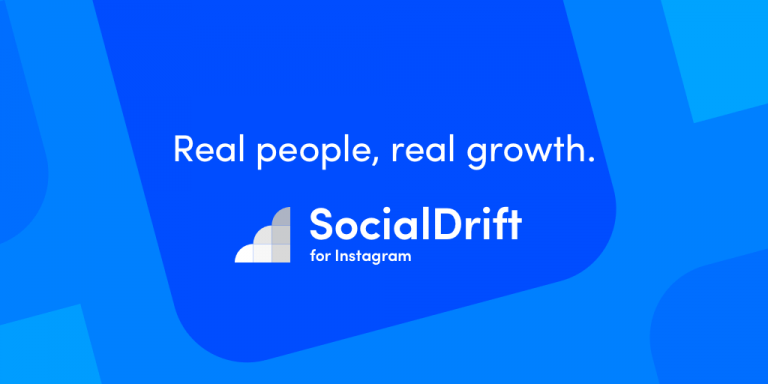
SocialDrift lets you organically increase your Instagram followers by using machine-learning algorithms to engage with other Instagram users through automated likes, comments and follows. This tool allows users to set specific parameters about automated outreach related to account location, name or hashtag use.
How can SocialDrift help you get more followers?
- It targets the right audience
Using SocialDrift filters, you can target users by hashtags, usernames, locations and more. Customize the settings to match your strategy.
- It automates your activity
You can enable the activities that you want your account to perform and SocialDrift will automatically execute them for you.
- It grows your following base
SocialDrift takes care 24/7 of all the work and supports you to level up your Instagram presence.
- Turbo Mode
Do you need to grow your Instagram account really fast? TurboMode can help you achieve this objective.
- SecureBoost™
SecureBoost is SocialDrift’s proprietary boosting engine, which ensures your account stays within limits.
- Included Proxy
Each Premium account comes with a Dedicated Proxy.
- Artificial Intelligence
SocialDrift uses AI to optimize your account. The more it runs, the better the results get!
- Growth Reports
Get weekly/monthly reports on your account’s evolution.
- Compliant with Instagram ToS
SocialDrift is compliant with Instagram’s terms to keep your account safe at all times.
How many Instagram followers can SocialDrift get for your account?
This information is not disclosed.
How much does it cost?
Here are the pricing plans of SocialDrift:
- 3-day free trial
- $13/week
- $39/30 days
Not happy with what SocialDrift can do for you?
No worries!
Let’s go to tool no 2.
2. SocialStud.io

SocialStud.io boasts a client base of over 2000 all around the world with different goals and profiles. They provide you 100% real, organic followers and outstanding growth by engaging with community that might be interested in you. They also provide advanced filtering so that your account never follows fake people.
How can SocialStud.io help you get more Instagram followers?
- Customised Marketing Strategy
SocialStud.io creates a custom marketing strategy for every account to maximize growth of the follower’s account, engagement, even sales.
- 24/7 management
Sign up and afterwards you will be assigned to a manager who will be responsible for your growth and will contact you via email.
- Hashtags
This tool uses hashtags to engage (follow/like) with users that would be interested in your offering.
- Location
Are you running a local business? This tool can target one or multiple cities, states, provinces, or even countries.
- Competitors
Do you have competitors on Instagram? This tool will target and engage with their followers, which is the fastest route for growth.
- Reposting
Do you want to automate content posting? SocialStud.io can repost pictures from multiple accounts.
- Weekly report
Your appointed manager can provide an in depth weekly report if you request.
How many Instagram followers can SocialStud.io get for your account?
Depending on many factors like your current account position, engagement, content and popularity, this tool can get you anywhere from 50 to 500 followers per day.
How much does it cost?
Here are the pricing plans of SocialStud.io:
- 7-day free trial
- $49/month
- $69/month
- $99/month
If this tool doesn’t hit the sweet spot for you, there’s one last chance: tool no 3.
3. Social Bloom

Personal trainers, influencers, make-up artists, aspiring models, actors, local and e-commerce businesses use Social Bloom.
How can Social Bloom help you get more Instagram followers?
- Like
Your Instagram account will ‘like’ your target’s posts, hundreds of posts, every day. This will result in massive amounts of exposure as you appear in people’s notifications. This is an effective way to grow your Instagram account. You can like photos tagged with a specific #, like the photos of all people who follow a specific artist or personality, like all photos geo-tagged at a specific location.
- Comment
You can automate your commenting to your target audience’s content. If you’re a business targeting potential clients, Social Bloom can comment things like: Awesome photo, use CODE10 for a 10% discount on my product! or DM me for a discount code on our fashion line! This can be used to drive sales and traffic. However these are not the only benefits of commenting – people love receiving comments and when someone reads your comment, they have a high chance of following you.
- Following
Following is a very strong method to grow your Instagram. When you follow people, they have a very high chance of following you back.
- Locations
Target and interact with accounts based on geo-tagged locations. This may be useful if you want to drive quality users from a certain location, or if you’re a local business to bring more people into your brick and mortar business.
This tool can even target locations based on your niche. For example, if you’re a shoe shop, you can target people who have geo-tagged their media at a specific shoe shop. This will ensure you get people who are interested in shoes and live or travel to a specific location.
- Blacklisting
Blacklisting allows you to exclude specific usernames from your activity. This works great to exclude competitors or other accounts from your Social Bloom activity. That means you will never follow, unfollow, like, or comment on media from the users on this blacklist. As you know, it could look rather odd for you to comment on your competitors’ posts. Luckily, the Blacklists feature can prevent that!
How many Instagram followers can Social Bloom get for your account?
Social Bloom states that your Instagram following can grow with 200 to 3,000+ real followers per week.
How much does it cost?
Here are the pricing plans of Social Bloom:
- 3-day free trial
- $16/week
- $22/week
- $40/week
- $90/week
There they are: SocialDrift, SocialStud.io and Social Bloom.
All you need to do is find out what’s important for your Instagram account and choose the right tool!
How To Engage With Your YouTube Subscribers To The Full Potential
Over the years, YouTube has become the go-to place for content creators to showcase their amazing work to a massive audience. YouTube gets over 30 million visits a day, according to blog.elink.io. And in a period of time when Facebook is pushing a lot on video content, YouTube decided it’s high time it got back on its target radar as the number one video platform out there. Therefore, one of its moves was creating YouTube Community, a place for YouTubers to interact with their fans and followers in a very friendly environment. The YouTube Community gives creators a space to post various types of status updates – polls, pictures, text, GIFs, links and more. Subscribers and other visitors can then like or comment on these posts.
At launch, YouTube had extended the feature to just a few creators, and, according to engadget.com, the rollout has been slow ever since. But the response has been pretty positive and YouTube said it planned to add more channels following the launch. And, in fact, at the end of November last year, YouTube today announced that its Community feature is available to anyone who has a channel with more than 10,000 subscribers. The YouTube Community tab replaces the Discussion tab, the place where creators and viewers used to have general conversations. The main difference between the Community tab and the Discussion tab is that the Discussion tab was purely text-based, whereas the Community tab allows a variety of posting and discussion capabilities.
To get inspiration for your own community posts, follow the community posts of channels you subscribe to by visiting their Community tab or by viewing the Subscriptions tab of the YouTube app.
“It’s extremely important to engage with your users in the comments section. Try to respond to every comment you get; not only will this help your video engagement, it’ll help you mold your community as you see fit. Also, the more engaged a specific user is with your channel, the higher the likelihood that your videos will make it into their emails and notifications,” wrote Jayson DeMers for Forbes.
How to use the community tab feature to its best capacities? Here are some steps that will help you along the way:
- Tell your followers about the new feature and how you intend to use it, for them. To add a link to your Community tab in the video description, open the tab and copy the URL from your browser’s address bar. Share the video on your Community tab to make sure first-time visitors to this tab know what they can do to engage with your channel.
- Reach more. Try cross promoting other channels and creators, or promote your own second channel through the Community tab. This is a handy way of increasing your reach and letting people know about the other content that you care about.
- Make sure your subscribers enable the notifications. You may use a video or a community post (or both) to let subscribers know how to get notified about your latest channel activity. Tell them that they need to click the bell icon to the right of the button they use to subscribe.
- Use polls to get to know more about your target. Polls are a great way in which you can easily find out if they liked your video or not or what they want to see next. You can then refine your content based on their suggestions and provide more quality content to your audience.
- Promote your products. “Post a status update to the tab with an image of your product and a link to the product’s sales page. Consider creating a special landing page on your website for your channel subscribers and offer an exclusive discount just for YouTube visitors to measure the results,” said socialmediaexaminer.com.
- Create teasers with the following content of your videos or/and of important launches and events you have for your brand. Offering this exclusive new content will spark their interest and get them on your channel when you launch the new finished product or service. At the same time,you can also promote successful past videos for the people that haven’t seen them yet.
- Share exclusive GIFs and memes. Don’t forget we all want to have fun and enjoy our lives and we were drown to the social media platforms because they offered just that. A brand that can show emotion and humor is a brand that will always win people’s hearts and one that they can relate to.
Are “micro-influencers” relevant for your marketing strategy?
After the era of influencers, the end of 2017 and all of 2018 seems to be heading on the trend on micro-influencers. Even the micro influencer may only have a few thousand followers, what they lack in numbers they make up for in their ability to maintain authenticity. They engage with their audience with honest product reviews and purchase recommendations.
The number of social media users worldwide is expected to reach 2.77 billion in 2019. Social influencers provide a return on investment of $6.50 for every $1 spent by businesses. Moreover, influencer marketing generates 11X higher ROI than traditional forms of advertising each year. Therefore, there is no wonder that, according to eMarketer, 48 percent of marketers decided to increase their budget for influencer marketing in 2017.
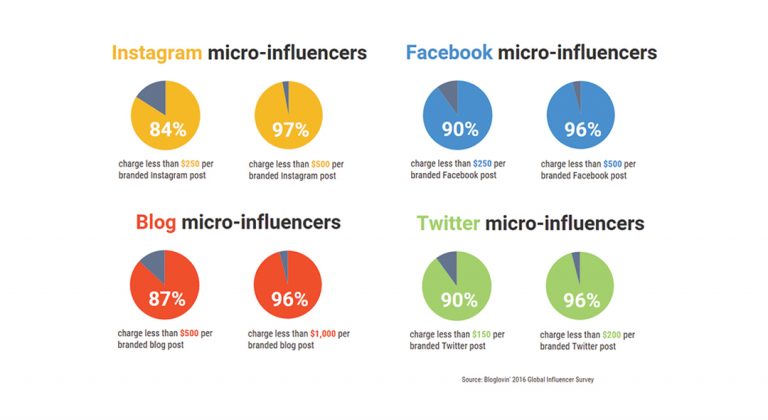
According to Forbes, an account with over a million followers can earn $50k for a single sponsored post (depending on its engagement). “Marketers have noticed that once an account is over a certain size, however, fewer people bother to engage questioning the value of a multimillion army of fans. The ratio of likes and comments to followers peaks when an account has around 1,000 followers. Get more than 100,000 followers, and engagement starts to flatten out; users just aren’t as keen to interact with a celebrity as with someone they can relate to more closely,” wrote The Startup. Moreover, they are commenting that 60 percent higher campaign engagement rates are driven by micro-influencers; those campaigns are 6.7 times more efficient per engagement than influencers with larger followings, which makes them more cost effective; and micro-influencers drive 22.2 times more weekly conversations than the average consumer.
At the same time, according to a study by Dr. Jonah Berger (author of the book Contagious: Why Things Catch On), quoted by HootSuite, 82 percent of consumers were “highly likely” to follow a recommendation made by a micro-influencer. In the study, an unpaid network of American micro-influencers were surveyed about the brand-related conversations they have compared to a group of average consumers.
I believe that all of those indicators, together with the fact that they get bigger engagement and are consider to be trustworthy by consumers, represent enough reasons for brands to start using them even more in their campaigns. If you are a smaller brand or company, or if you have a creative,different and more interesting campaign, or if you have a niche campaign, the micro-influencers are the best solution for you. Micro-influencers are the trend that is here to stay.
Big influencers attract thousands of dollars for just a post on social media
Only 3% of the marketers said they planned to cut back on influencer marketing in the coming year, versus about 75% who anticipated spending even more on it, says emarketer.com. Moreover, according to the website, companies are paying the most for celebrity posts, especially on certain platforms. On average, posts by celebrities with at least 1 million followers (considered as influencers) cost nearly £65,000 each ($87,731), with Facebook posts demanding a leading rate of approximately £75,000 ($101,228).
Influencer marketing costs are going up in the UK, according to research by Rakuten Marketing and Morar Consulting, but prices per post vary considerably depending on reach and platform. This month, polling of UK marketers working directly on influencer programs from sectors including fashion, beauty and travel, approximately two-thirds of respondents had seen the prices influencers charge for posts go up in the past 12 months. In some industries, the costs were even higher, with some premium fashion brands, for example, paying celebrity influencers more than £160,000 ($215,954) per post.
“UK marketers are willing to pay celebrity influencers on Facebook up to £75,000 for a single post mentioning the brand they want to promote, a new survey has revealed. They are also prepared to pay celebrity influencers £67,000 for each YouTube video that mentions their brand, while key influencers on Snapchat can expect to be paid as much as £53,000 per Snap,” writes www.warc.com.
Spending was much more modest for so-called micro-influencers—those with 10,000 or fewer followers, due to the fact that only a fifth (20%) of marketers claim they are able to demonstrate the impact of influencers through indirectly influenced sales. Prices averaged at close to £1,350 ($1,822) per post, with YouTube and Facebook commanding the highest prices—more than £1,500 ($2,025)—and Snapchat the lowest at just over £1,000 ($1,350).
“Decision makers questioned from across a variety of sectors including fashion, FMCG, beauty and travel admitted that they would shell out as much as £53,000 per Snapchat post, which despite coming in at significantly less than the value they placed on other platforms, is notable given that Snapchat’s ephemeral nature means videos and pictures disappear within 24 hours of being posted,” said Rebecca Stewart for thedrum.com.
Overall, respondents said they would devote an average of 24% of their marketing budgets to influencer marketing in the next 12 months. That figure’s higher than the share of budgets that the largest percentage of marketers in the UK and US said they devoted to influencer marketing in a March 2017 study by Econsultancy. In that study, between half and six in 10 luxury and non luxury brand marketers said they invested less than 10% of their overall marketing budgets to influencer marketing. But the second largest shares of respondents were similar in their spending allotment to those in the Rakuten and Morar study.
Affiliate marketing firm Rakuten Marketing spoke to 200 UK marketers working on influencer programmes and found that post-for-post they were prepared to pay 12% more for Facebook endorsements than they were for YouTube. The research also found that despite the value brands clearly place on high-profile influencer slots, the majority of those asked (86%) admit they aren’t entirely sure how influencer fees are calculated. Which is pretty odd, especially after the last years of change in the media buying market, the restriction of budgets and the overall risen caution.
Why are the influencers so important for marketers when it comes to social media? According to The Economist, social media offer brands their best opportunity to reach cord-cutting millennials: Snapchat, for instance, reaches 40% of all American 18- to 34-year-olds every day.
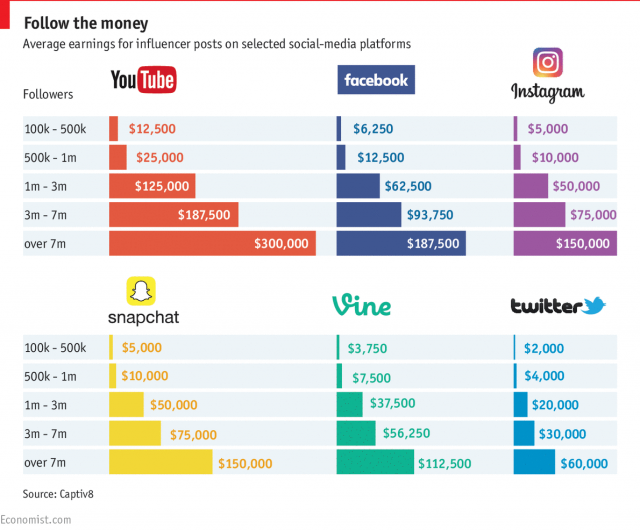
“Moreover, these platforms can make consumers feel they have gained unprecedented access to the lives of the rich and famous. That lets sponsors interact with their target audiences in ways that traditional advertising cannot match. In turn, demand from marketers for these channels has made social media lucrative territory for people with large online followings,” wrote the famous business magazine.
On the other hand, while 59 per cent of marketers state the influencers they work with will take guidance from them around best practice, 56 per cent of premium fashion marketers admit to a situation in which influencers hold all of the power. For example, only 20 per cent of marketers state influencers are prepared to follow their lead when it comes to guidance around billing.
Less than a third (29 per cent) believe that the influencers they work with are entirely concerned whether their content drives sales for the brand. Interestingly, when asked what would encourage marketers to invest more in an influencer programme, greater transparency and better reporting of influencer contribution to sales now rank as the highest factor (50 per cent).
James Collins, Rakuten Marketing’s SVP/managing director, global attribution, comments, “Influencer marketing can be hugely effective but marketers are commissioning expensive posts without understanding the real impact on the purchase journey. It’s essential that marketers question influencer fees and use attribution tools to measure the effect of this activity in order to create strong, value-driven relationships between brands and influencers.”
6 Instagram Policies And Tools Often Overlooked
Instagram has a licence to use your content
If you’re posting images on Instagram, you’re giving up some control of your content. As outlined in the most current Terms, the license you grant Instagram is “a non-exclusive, fully paid and royalty-free, transferable, sub-licensable, worldwide license to use the Content that you post on or through the Service.”
This means you’re granting Instagram the rights to use your pictures (although you can still grant those rights to anybody, not just Instagram [non-exclusive]) and Instagram doesn’t have to pay you anything (fully paid and royalty-free) no matter how they use your pictures (even if they happen to make money off of them). Instagram also has the right to transfer this license to anyone in the world (transferable and worldwide) and even sell that license without having to pay you anything (remember royalty-free).
What it means in essence for you and the brand to are taking care of is that, after posting on Instagram, you no longer have any control on what will happen with that post, as anybody can repost it, with their own personal comments and ideas.
When it comes to Instagram contests, you must provide complete rules and terms
Instagram contests and giveaways are super-popular these days. They’re a great way to gain followers and additional exposure for your business. However, there are a few things you need to do to make sure you’re complying with Instagram’s promotional rules. The key is that your contest post must include (1) acknowledgment that the promotion is in no way, shape, or form “sponsored, endorsed or administered by, or associated with” Instagram; and (2) a release of Instagram by each person participating in the contest. “In your contest rules, also include the terms, any eligibility requirements, and the prizes offered. You can list these rules directly in the post or link to a separate website that includes this information, plus other contest rules. Also, make it clear to participants that they can’t inaccurately tag content,” said socialmediaexaminer.com.
It’s really important to use hot and trendy hashtags
It’s not enough just to use the hot hashtags. Your goal is to use the most relevant and highest traffic hashtags. Hashtags are the Instagram equivalent of keywords, so you need to find out which ones your target users are most likely to click on and here is the part where the research gets involved. You must search and see who are the best hashtags for your target and to them, as they are the ones that will get relevant traffic. If you’ll make sure to pick the right keywords, relevant and targeted, you’ll gain a lot more popularity and followers. If you choose the wrong hashtags, you won’t get the level of engagement that you’re looking for.
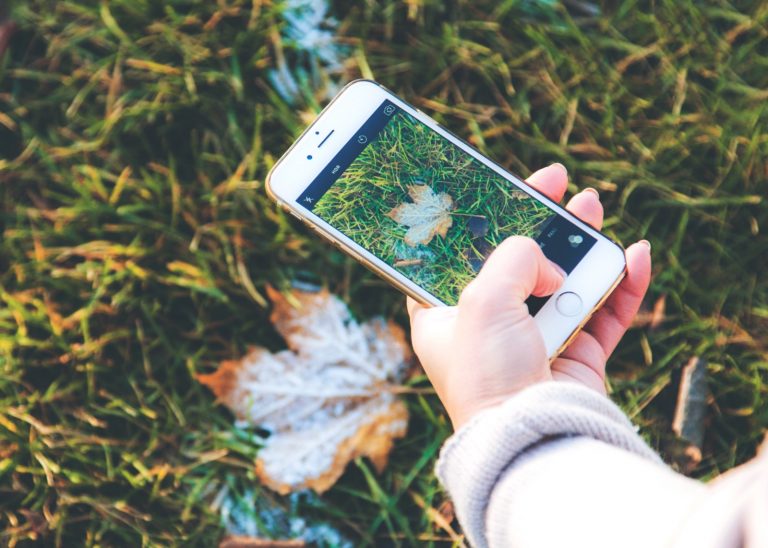
Comment on other people’s or brands’ pictures, don’t just like them
A research showed that on Instagram, there are 575 likes every second, but only 81 comments. People like photos 609% more than they comment on photos. Obviously, it’s easier to double tap a photo than it is to tap comment, and then think of something creative to say. When you go to that extra effort, people like that. They’re more likely to tap your profile and follow you. You can also get a lot of exposure by leaving meaningful comments on the photos of other people. When you leave a thoughtful and positive comment, there’s a good chance that the author of that photo will become curious to check out your profile.
Using direct messaging
You have the possibility to message your followers, but, unfortunately, few brands use it at its full capacity. Of course you need to it elegantly and from time to time, making sure you are not annoying your followers with every update. But, it is a great tool to leverage when you want to announce something big, like a rebranding, new product line, a sale, or a company merger.
Attention to the bio
On a social media platform where pictures and videos are the stars, your company bio must be creative and smartly written. Make sure to highlight all your key points, using short and to-the-point sentences. Don’t make it crowded and suffocating.
5 Free Instagram Analytics Tools for Marketers
Finding the right strategy that will for sure help your brand is not an easy task. The right Instagram tools can provide analytics to inform your social media strategy and content scheduling. If you are looking for some free tools to help your business on Instagram, we have 5 ideas that would come in handy.
Instagram Insights
If you’ve set up your Instagram business account, you have access to free analytics through the Instagram app. Instagram Insights provides basic stats for assessing your Instagram marketing efforts. Find out more about your followers, when they’re on Instagram, and what your top posts are. This information will help you choose content more likely to resonate with your audience.
To access these insights, tap the bar chart icon in the top-right corner of the app. The first analytics screen shows high-level insights for the last week and comparison stats for the week before. You can view your total impressions, reach, profile views, and website clicks. It also shows your top posts and stats for your Instagram stories from the last 24 hours. Swipe to the right to see your reach. Swipe right one more time to see website clicks data.
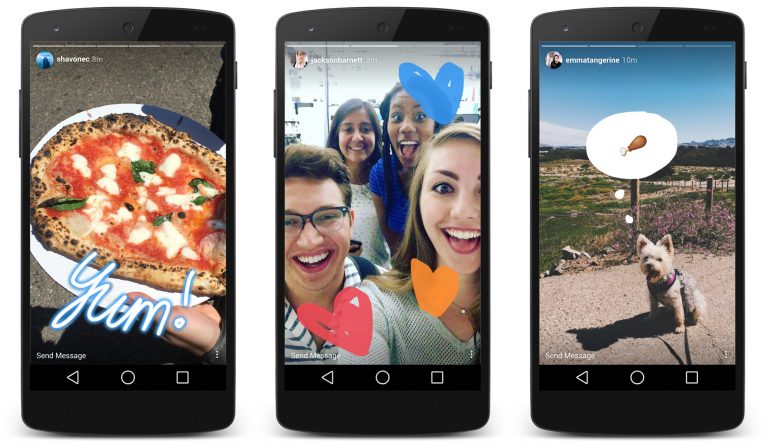
source: TechCrunch
You can also view your top posts insights, just by tapping the see more link next to top posts and the top six posts from the past seven days sorted by impressions. The tool also allows you to see followers insights. Back on the main Insights page for your account, scroll down to the Followers chart of times when your followers are on Instagram. Also, if you’re running paid Instagram ads, the Promotions section of the main Insights screen gives you relevant stats on your campaigns.
Socialbakers
With Socialbakers, you can get a free report on your most popular Instagram photos, filters, and hashtags, and all of your interactions with followers. The most useful sections are the most liked and most commented posts because this information can help inform the types of images you use in future Instagram posts.
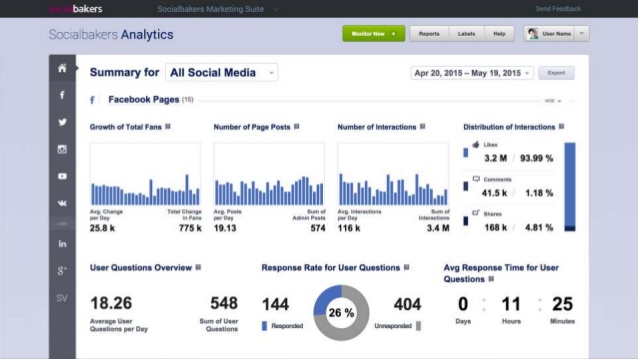
To get your free report, go to Socialbakers’ Free Instagram Analytics Tool and click Login With Instagram.
Simply Measured
Simply Measured offers a free Instagram report for users with up to 25,000 followers. The stats and insights are presented clearly and will help inform your Instagram posting strategy. The report lets you quickly see what has worked well in your Instagram marketing, so you can apply these insights to future posts. To get started, type your Instagram account name in the text box and click Authenticate With Any Instagram Account. Then log in and authorize Simply Measured to access information from your Instagram account. When you receive your report, you’ll find three tabs of information: Charts, Scorecard, and Appendix. The buttons in the top-right corner of the screen let you download the report to Excel or export it to PowerPoint.
On the Charts tab, you can view a wealth of insights about your most engaging posts and average engagement per post. Moreover, the Engagement chart shows Instagram engagement over time. See total engagement, engagement as a percentage of followers, and information on likes and comments your photos and videos received.
You can also examine the Scorecard (it gives you some basic stats about your Instagram account) and Appendix Tabs (check out a table of your top posts sorted by highest engagement with the date of the post, type, likes, comments, and total engagement – likes and comments).
It offers a free Instagram account checkup to assess how you’re doing on the network. While the report isn’t as comprehensive as some others, it offers handy nuggets of data for marketers. It helps you determine the best time to post, which hashtags to use, and what content to post more (or less) of. It also highlights your top followers and reminds you to engage with them. To access your free report, click Start Your Checkup on the home page and then sign up for a Union Metrics account.
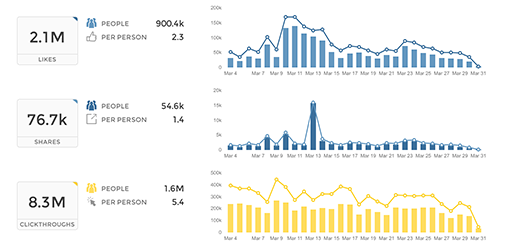
You can view the number of posts by day. Use the icons in the top-right corner of the page to share, print, or download your report. Scroll down to examine more stats with recommendations from Union Metrics, such as the best time and day to post. You can also view stats and visuals for your top-performing posts. If you click the circles on the hashtag report, you can see more information about the hashtags, which is a handy feature.
Squarelovin
With Squarelovin, you can get free basic Instagram analytics. The Optimization section offers insights that help inform Instagram posting. The “worst times to post” information is especially valuable. First, you’ll need to sign up for a Squarelovin account. On your dashboard, you can view high-level stats and access additional analytics screens. On the Postings tab, you’ll get information on your post history and top posts. It also shows your posts by year and month and day and time. The Engagement tab shows information on likes and comments, and highlights the top liked and top commented posts. The Optimization tab shows the best time and day to post on Instagram, but also the worst times to post on specific days.
If you use different filters on Instagram, you can also view the impact of those filters. Moreover, the report lets you see all of the Instagram hashtags you’ve used next to a list of the most popular hashtags. You can quickly see if you’re using top hashtags or if you need to rethink your hashtag strategy.
Understanding whom your Instagram fans are and what content they engage with and when will give you ideas for future content to share on the network.
How often should you post on social media until it gets annoying?
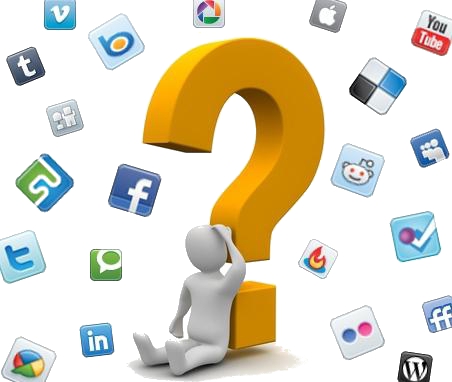
Too often? Too little? Not enough? Too much? One of the most important questions that rise when thinking about the social media strategy for your brand. The frequency of updating your pages on social media is a key factor to the social media account’s success.
When it comes to Facebook there is a public, known rule of two posts a day that, according to Forbes, is a rule that works if you are handling a substantial Facebook following of at least 10,000 followers. “Whenever you have an audience of this size, there is almost no disagreement that posting twice a day is the way to maximize clicks and engagement on your content. But what if you have a smaller following? Say only a few thousand, or even a few hundred? Does this rule still apply?” added the Forbes editors.
The answer, as expected, is complicated and not easy to be given. It takes testing, learning more about your followers and listening to the specialists and paying attention to their pieces of advice.
With over 1 billion accounts Facebook is the place to be. But, not every fan you have on Facebook will see everything you post. And that due to Facebook EdgeRank. The more your followers like, share and comment on your posts, the more likely they are to see them in the first place. This is where great content comes into play. Your followers will want to comment, share or like posts that keep their interest, make them laugh or teach them something. The advice given by yahoo.com would be to post at least 3 times a week, but every day would be even better. You don’t have to create all the content; share fun pictures, e-cards or posts that you think your followers will like. Sharing counts towards EdgeRank and engagement.
According to coschedule.com, when it comes to Facebook, the recommended posted time is one post a day, between 1-4 pm. Curate or re-share a post every other day. Ahalogy suggests that posting to Facebook no more than once a day is best or you’ll start to feel spammy. Buffer says you can post to Facebook twice a day before likes and comments drop off. Constant Contact says to post on Facebook a minimum of three times per week while keeping your maximum posting frequency to 10 times per week. DowSocial says two Facebook posts per day as a minimum works well for increasing your reach. They also suggest that sharing fewer posts and then promoting them is the best way they’ve seen to increase their engagement. HubSpot’s benchmarks suggest to post to Facebook a minimum of three times a week. They say to set your maximum number of Facebook posts to 10 times per week.
LocalVox likes to post once a day to Facebook as a maximum while three times a week is their suggested minimum. Nulou suggests to post a minimum of three times a week to maintain your consistency while keeping your maximum number of Facebook posts to no more than 10 a week. Quick Sprout found that Facebook pages with smaller amounts of followers should post about 16–30 times a month, or roughly once every day or two. If you have a bigger fan base, Neil Patel suggests posting at least 31 times a month, which he says is about once or twice a day. Mari Smith recommends 5–6 Facebook posts per week. And some good advice: Skip weekdays if you have to, but not weekend days, since Facebook users tend to be active on the weekends and in the evenings.

source: CoSchedule
According to yahoo.com, unlike Facebook, on Linkedin you won’t need to post things quite as often, maybe a couple times a week, if you have important things to share. Be sure to participate in groups, they’re great for establishing thought leadership and making connections on your industry. This is a place to network with others in your field and maybe find new business, so share blog posts, events and relevant info for your industry.
Important is once again to test and see what kind of content your fans and followers interact with, in order to find your own post frequency sweet spot. Keep in mind that your followers may have many different schedules and you may find more comments, shares and retweets happening around 8 pm rather than at noon so give it a try and see what works best.
The specialists consider that the best frequency of posting is one time a day, between 10-11 am. Buffer says 20 posts a month or posting once a day helps you reach 60% of your followers on LinkedIn. Constant Contact recommends posting on LinkedIn at least two times per week. Post a maximum of five times per week. DowSocial recommends sharing daily to LinkedIn, but doesn’t provide a solid number. They suggest that daily shares keep your followers in the loop, but not overwhelmed. HubSpot’s benchmarks recommend posting at least twice a week, while your maximum posting frequency should be no more than five posts per week. Nulou says to post to LinkedIn a minimum of two times a week to maintain consistency while five times a week should be your maximum number of posts. Quick Sprout cited LinkedIn’s own recommendations for an ideal posting frequency of 20 times a month, which is about once every business day.

Source: ShortStack
